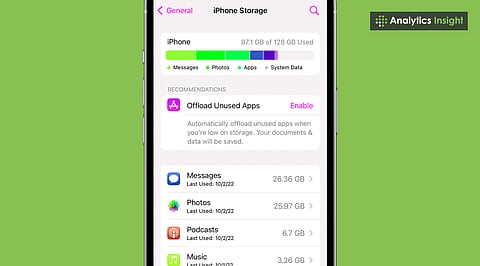

Cleaning the cache periodically also improves speed and performance and eliminates storage problems.
Safari, Chrome, and various social media apps generate cache that slows down browsing and usage.
Offloading or reinstalling the app removes unnecessary files but keeps important user data intact.
Historically, iPhone models have always faced storage problems. Over time, apps and browsers store temporary files called Caches, which can be a nuisance if they occupy valuable space or affect the device's performance.
To keep the device fast and responsive, it is essential to know how to clear the cache on an iPhone. This article outlines practical steps for freeing up space, removing unwanted files, and enhancing overall functionality.
iPhone cache is temporary data stored by apps and browsers to improve performance. It consists of cookies, scripts, images, and other files that help apps and websites load faster.
Even though Cache makes life easier, it sometimes accumulates enough to consume gigabytes of storage. Frequent clearing of the Cache keeps apps running smoothly, prevents warnings for lack of storage, and removes unnecessary clutter from the device.
Safari, the default iPhone browser, stores a large cache over time. To clear it:
Open Settings.
Scroll to Safari and tap it.
Tap Clear History and Website Data.
Confirm by selecting Clear History and Data.
Clearing the Safari cache means removing cookies, history, and cached files. Clearing storage space will help to accelerate webpage loading times and increase surfing speed.
Many apps accumulate a large cache that can impact performance. iOS does not provide a direct way of clearing the Cache for most apps, but alternatives do exist:
Go to Settings
Select General
Click on iPhone Storage.
Scroll until you find the App you want to manage.
Tap on Offload App to remove the App but keep its data, or Delete App to remove everything.
This is especially useful when offloading social media or messaging apps that keep huge amounts of temporary data. It saves storage without losing important files.
For users who prefer Chrome, clearing browser cache is just as important:
Open the Chrome app.
Tap the three dots at the bottom-right corner.
Navigate to Settings
Go to Privacy
Clear Browsing Data.
Select Cached Images and Files, and click on Clear Browsing Data.
This removes the stored files, which can make browsing slow. If maintained regularly through Chrome, cache clearing will ensure that websites load faster and prevent unnecessary cache storage.
Apps such as Instagram, Facebook, and Twitter also create Caches. If the App does not have an inbuilt option to clear the Cache, offloading or reinstalling it would be the best approach.
This process will clear the data stored by apps that accumulate without affecting user-specific files, such as photos or messages. Doing this occasionally helps the apps run smoothly and prevents excessive storage usage.
By restarting the iPhone, users can eliminate temporary system files that are not generated by apps. Hold the power button, tap the slide to power off, and restart. The restart revives the system, resolves minor glitches, and theoretically aids regular cache clearing. A minor adjustment like this can significantly improve a device's response time.
Maintaining the Cache always keeps an iPhone quick, responsive, and efficient. When users clear caches in Safari, Chrome, and apps, they free up storage and improve speed.
Offloading apps to keep key data, but eliminate cache files that users don't need. Combined with periodic restarting, these steps should create an enjoyable experience for the user when operating their iPhone, consuming less storage to reduce slowdowns.
An iPhone cache clean is a method to boost the device's performance and free up storage space. Temporary files created by Safari for social media apps increase clutter and slow down the device. Offloading apps and restarting the iPhone provide additional benefits.
Following these steps should allow one to clean up iPhones that remain efficient and responsive without a hint of data loss. Caches that are maintained regularly lead to enhanced performance and free up space that can be occupied by important files.
1. What is cache on an iPhone?
Cache consists of temporary files created by apps and browsers to speed up loading. Over time, it can take up precious space and may need cleaning to enhance performance.
2. How regularly should I clear the cache on my iPhone?
It's based on usage. Browser or heavy app users should clear the cache monthly to keep the device's performance smooth. Light users can clear the cache every few months to optimize storage and ensure smooth functioning.
3. Does clearing the cache erase any crucial data?
No, clearing the cache erases temporary files and cookies. Users' important files, app data, and saved passwords will remain safe. So, it is safe to clear the cache to improve system efficiency without losing data.
4. How can the app cache be cleared without deleting it?
Go to Settings > General > iPhone Storage > select the app > tap Offload App. This will remove the temporary files while preserving the app's data and settings.
5. Is clearing the cache going to speed up the iPhone?
Indeed, cache accumulation puts more pressure on storage; clearing cache alleviates that pressure, stops app lagging, and makes navigation and usage smoother in both older and newer generation iPhones.
